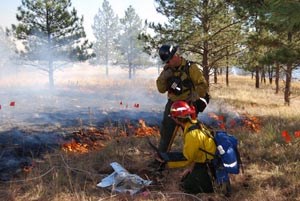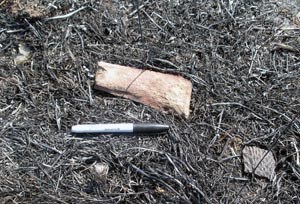Last updated: February 21, 2024
Article
Exploring the Fire and Archeology Interface

Today, NPS park managers must routinely manage the restoration needs of natural resources with the preservation of cultural resources. The NPS has instituted policies that incorporate use of wildland and prescribed fire. Under certain conditions, these goals may conflict with the need to preserve archeological and other cultural resources in parks. Studies have shown, however, that these goals are not necessarily mutually exclusive and that, with sound scientific information, park managers can balance archeological preservation and ecosystem restoration and maintenance.
There is a growing literature addressing the fire/archeology interface. Studies have ranged from pre- and post-burn archeological inventories to assess the impacts or potential impacts on archeological resources, to material studies that provide baseline information on the specific impact of fire. Previous studies, however, have been primarily focused on fire conditions and archeological resources in areas of the U. S. where major wildland fires occur on an annual basis, primarily the western and southwestern states. Prior to the current study, parks in the Midwest lacked specific information concerning local fire behavior and impacts to resources.
To address this problem, the Midwest Archeological Center (MWAC) worked with Midwest Region Fire Program to design and carry out experiments to collect information about the effects of fire on various classes of archeological materials. The goals of this project were to assess the fire/archeology interface to provide managers of Midwestern parks with information that will aid in decision-making concerning the stewardship of archeological and natural resources. Many park managers are forced to make decisions about the use of fire and the preservation of archeological resources without benefit of scientific data that would enhance the decision-making process and allow a more effective use of prescribed burning without impairing the preservation of the archeological record.
A number of studies have already demonstrated that fire can have significant impacts on the archeological record and potentially lead to the loss of information about past cultural groups. The present experimental research on fire conditions (fire temperature and duration) and observation of the effects of fire on multiple classes of archeological materials routinely observed at archeological sites was designed to build on this baseline information. Research questions that were addressed during experimental study include:
- What are the fire conditions typical for specific environmental zones within the Midwest?
- What conditions are created when different firing techniques are used (head, backing, and flanking fires?
- What impacts (if any) can be observed on artifacts subjected to different firing techniques?
- What environmental/fire conditions produce changes in surface archeological materials?
- Can minor impacts such as glazing, charring, and sooting be removed during cleaning in the laboratory?
- What artifact classes are the most or least impacted during the experimental burns?
Research Design
The experimental fire effects study utilized a multi-step comparative analysis approach to identify and assess impacts to archeological resources. Information on fuel types, fuel loads, fire temperatures, and burn duration provided a measure of fire conditions that could be linked to individual artifacts and impacts observed on each item. By employing these experimental techniques, the qualitative artifact analysis was linked to burn conditions. The potential impacts on classes of archeological materials from different types of prescribed burns could then be assessed.
The outcomes from these experiments include: 1.) accurate data on the temperature and duration of the fires; 2.) records of the impacts on archeological resources; 3.) assessments of the impacts to archeological resources; and 4.) recommendations on alternatives for mitigating the impairment of the archeological records.
Research Setting
The NPS Midwest region covers 13 states and includes several distinct regional ecosystems. Midwestern parks also contain a diverse set of archeological resources ranging from 12,000 year old prehistoric sites to the homes of former U.S. presidents. This diversity of ecosystems and archeological resources makes a “one size fits all” approach to the fire/archeology interface problematic.
Six national park units, two parks from each of three distinct environmental zones, were chosen as research sites. Each study site presented a unique set of fire conditions and archeological resources. Buffalo National River and Pea Ridge National Military Park are both located Arkansas in the Ozark highlands. Effigy Mounds National Monument, Iowa and Voyageurs National Park, Minnesota, represent the eastern woodlands ecological zone. Plains environments are found in Tall Grass Prairie National Reserve, Kansas, and Wind Cave National Park, South Dakota. The parks reflect the regional diversity of environmental zones, archeological resources, and prescribed burn programs throughout the Midwest.
Experimental plots in sets of three were established at two locations in each park that were representative of the typical archeological and environmental conditions. Experiments were designed to model the typical fire conditions and archeological resources at each park in order to best address the needs of the park managers. Choice of plot for burning was influenced by 1.) local needs of each park; 2.) typical burn conditions (fuel types, fuel loads, moisture content, seasonality); 3.) archeological resources or representative materials that are typical and most threatened by fire at each park; 4.) prescribed burns already planned and scheduled by the park; and 5.) accessibility and which did not require extraordinary efforts to undertake the experimental burns and recording of archeological data.
Pre-Burn Artifact Analysis
A key component of the project was collection data on the qualitative and quantitative changes in artifacts subjected to fire. An initial task of the project was to procure assemblages of replicas and deaccessioned artifacts and artifacts lacking provenience that reflected the archeological resources of each individual park. Representative materials included replica prehistoric stone tools and waste debris, unprovenienced prehistoric pottery, bone and shell, and historic materials such as ceramics, bottle glass, kaolin pipes, metal cans, lead projectiles, and construction materials. The artifacts were used to create artificial sites for assessing the impacts of prescribed fire. A representative assemblage of 192 artifacts for each park allowed for an arrangement of 32 artifacts per plot.
All artifacts were analyzed for previous wear, damage, and condition prior to being subjected to prescribed fire experiments. Artifacts were measured, weighed, and photographed prior to burning.
Pre-burn analysis was necessary in order to describe all the changes observed on artifacts after they had been burned. Buenger (2003) outlined methodologies for assessing the impacts to archeological resources and provided a basis for analytical methods used during this project.
Prescribed Fire Experiments
Representative archeological materials were arranged in experimental plots that were then subjected to a prescribed fire. Weather, soil, and fuel load data for each individual unit were collected prior to ignition. Data on fire temperature and burn duration were recorded using Omega OM_CP_OMTTEMP eight channel thermocouple data logger with Type K thermocouples placed in the center of each plot. The eight channel data loggers collected simultaneous readings for each of the eight thermocouples at five second intervals. The collection points for each data logger were located at the ends of eight 12-foot thermocouple wires arranged in a radial pattern. Artifacts were placed on the ground surface surrounding the ends of each thermocouple wire. Ignition of individual experimental plots (head, flanking, and backing fires) allowed fire monitoring data such as flame length, flame depth, and rate of spread to be calculated.

Post-Burn Analysis
After fires subsided, artifacts were collected and assessed for fire-related changes. Analysis of data from experimental studies showed both expected and surprising results. Post-burn analysis was conducted using similar methods and analytical categories that were used during the pre-burn analysis. Impacts such as cracking, charring, sooting, combustive residue, fracture, scorching, and melting were recorded. Artifact weight, dimensions, and color change were also measured. Linking these variables with the data on burn temperature and duration allows researchers to assess the impacts of fire on the representative assemblages.
Major findings include:
- The majority of artifacts subjected to fire during the six prescribed burns did not experience any significant impacts.
- The adherence of combustive residue to artifacts was the most frequent impact observed on artifacts. Between 48 and 75 percent of each assemblage exhibited low to high amounts of combustive residue. With effort, combustive residue was removed from the more durable classes of artifacts, such as glass and stone.
- Cleaning and weathering experiments on archeological materials demonstrated that most impacts to surface artifacts were of a non-permanent nature and could be removed with light to moderate cleaning.
- Serious impacts to artifacts such as scorching, fracturing, or melting were observed in only 5-10 percent of the assemblages.
- The incidence of serious or significant impacts to the artifact assemblages was a combination of fuel type/fuel load and artifact material. Artifacts such as bone, shell, leather, wood, and lead exhibited more frequent serious impacts when compared to materials such as ceramic, stone, metal, and glass.
- Experimental prescribed burns demonstrated a significant amount of variability in fire conditions resulting from non-uniform fuel types and loads, particularly in wooded environments.
Conclusion
Results of this project have provided a better understanding of the fire/archeology interface in different ecosystems in the Midwest. With this data, park managers will be able to more effectively coordinate the needs of natural resource management with archeological resource preservation. Park managers will now be better equipped to identify archeological resources threatened by wildland fire and take measures to reduce or mitigate these impacts.
This multi-park research program has provided valuable data for assessing impacts and potential for damage to the archeological record from applications of prescribed fire. By producing data and predictive models specific to material type and impact models specific for environmental zones in the Midwest, park managers will be better equipped to evaluate the fire/archeology interface than if they relied solely on data generated from other parts of the country. The Midwest region fire effects research is only the first step to establish baseline data for the region. Future studies will be able to use this baseline to explore numerous other questions regarding the fire/archeology interface in the Midwest.
Acknowledgements
This research was funded through a cooperative agreement between the National Interagency Fire Center, Joint Fire Science Program and the National Park Service. Special thanks to all the NPS, Nature Conservancy, and U.S. FWS fire and support staff that assisted our team over the last three years. More information about the project is available in Experimental Study of Local Fire Conditions and Effects on Surface or Near-Surface Archeological Resources at National Park Service Units – Midwest Region. JFSP Project Number 06-2-1-05.
References
Buenger, Brent A.
2003 The Impact of Wildland and Prescribed Fire on Archeological Resources. Unpublished Ph.D. dissertation, Department of Anthropology, University of Kansas, Lawrence.
